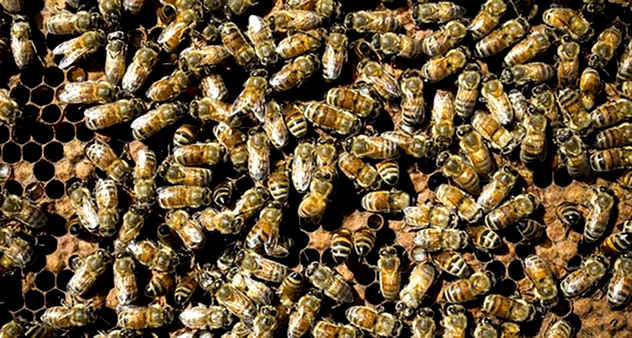 Technology
Technology  Technology
Technology  Humans
Humans 10 Everyday Human Behaviors That Are Actually Survival Instincts
 Animals
Animals 10 Animals That Humiliated and Harmed Historical Leaders
 History
History 10 Most Influential Protests in Modern History
 Creepy
Creepy 10 More Representations of Death from Myth, Legend, and Folktale
 Technology
Technology 10 Scientific Breakthroughs of 2025 That’ll Change Everything
 Our World
Our World 10 Ways Icelandic Culture Makes Other Countries Look Boring
 Misconceptions
Misconceptions 10 Common Misconceptions About the Victorian Era
 Mysteries
Mysteries 10 Strange Unexplained Mysteries of 2025
 Miscellaneous
Miscellaneous 10 of History’s Most Bell-Ringing Finishing Moves
 Technology
Technology Top 10 Everyday Tech Buzzwords That Hide a Darker Past
 Humans
Humans 10 Everyday Human Behaviors That Are Actually Survival Instincts
 Animals
Animals 10 Animals That Humiliated and Harmed Historical Leaders
Who's Behind Listverse?

Jamie Frater
Head Editor
Jamie founded Listverse due to an insatiable desire to share fascinating, obscure, and bizarre facts. He has been a guest speaker on numerous national radio and television stations and is a five time published author.
More About Us History
History 10 Most Influential Protests in Modern History
 Creepy
Creepy 10 More Representations of Death from Myth, Legend, and Folktale
 Technology
Technology 10 Scientific Breakthroughs of 2025 That’ll Change Everything
 Our World
Our World 10 Ways Icelandic Culture Makes Other Countries Look Boring
 Misconceptions
Misconceptions 10 Common Misconceptions About the Victorian Era
 Mysteries
Mysteries 10 Strange Unexplained Mysteries of 2025
 Miscellaneous
Miscellaneous 10 of History’s Most Bell-Ringing Finishing Moves
Top 10 Horrific Farming Nightmares
Farming is an exceptionally strenuous livelihood; the responsibilities and perils of the job are seldom realized or acknowledged. Animals, heavy machinery, crazed maniacs, and even manure all pose a threat to life and limb.
The following ten stories delve into the unthinkable and grotesque outcomes such a hazardous profession can entail, and also the senseless, tragic crimes that have befallen farmers on the outskirts of society.
10An Unforgiving Swarm

On a quiet Sunday afternoon, Rogerio Zuniga was on his tractor tending to his farm in Lorenzo, Texas, when the third-generation farmer hit an abandoned irrigation pipe. Unbeknownst to Zuniga, the 18-inch (45 cm) diameter piping housed an enormous hive of Africanized bees. As the enraged insects emerged from the darkness, a frightened Zuniga jumped off the tractor and ran 100 yards (91 m) before being overcome by the lethal swarm. When Zuniga’s family noticed that the tractor was abandoned, they searched the field only to discover the farmer’s lifeless, tattered body completely smothered in bees.
According to Zuniga’s sister Lisa, “He had gaping wounds, the bees shredded him basically. It was horrible.” Upon further investigation, the fire department discovered 15-20 feet (4.5-6 m) of honeycomb inside the pipe causing the county to get involved. As crews broke through the concrete piping, they became swarmed by the extremely aggressive insects with some even sustaining stings through their hefty veil. After four hours of cleaning out the irrigation pipe, the fire department noticed that the bees were relocating to another massive honeycomb located on the property where the victim’s mother resided.[1]
9Raging Bull

Roger Bearup’s last day on earth started off on a somber note, given that it was the birthday of his deceased son. Ten months prior, the 71-year-old buried his boy after his forklift struck a power line, electrocuting him. On this particular day, however, Bearup’s demise would not come from electricity but a feral bull on his western Michigan farm in Kent County’s Lowell Township.
In a fruitless attempt to corral the 1,500 pound (680 kg) raging animal, Bearup was fatally attacked. Authorities were alerted after a neighbor discovered Bearup’s body lying on the ground. Unable to assist his friend due to the aggressiveness of the bull, the neighbor hopelessly waited for police to arrive who immediately blocked off the driveway entrapping the animal. Fearing for their lives and given no other option, the deputies fired their cruiser rifles at the charging beast. In all, the bull was shot a total of 33 times before collapsing to the ground. It was later determined that the bull was roaming loose on the farmland after breaking through an electric fence prior to mortally wounding Bearup who sustained “massive injuries” in the attack.[2]
8Lone Survivor

In April 1937 John Waszak was emerging from his barn standing a mere 50 feet (15 m) from his two-story house when a blast lifted the home off its foundations. What remained was a pile of smoldering kindling along with the charred remains of his wife and eight children, aged three-years-old to 20. Six weeks earlier, Waszak had found 50 sticks of government-manufactured dynamite left behind by the previous owner in the farm’s pumphouse. Fearing his children would discover the explosives, Waszak moved the dynamite to the basement of the family home.
Unbeknownst to the Waszak family, the youngest child, Raymond, managed to find his way into the cellar while the rest of the family gathered in the living room. Moments later, the Waszak home exploded, scattering body parts and remnants of the house across an acre of land in Muskego, Wisconsin. On April 19, 1937, the Madera Tribune reported that Raymond’s body was “discovered in the basement, not far from where 50 pounds of pyrotol, a low-grade dynamite, had been stored.”[3]
7Accidental Decapitation

Surprisingly, accidental decapitations occur more often than people may expect. These horrifying and ghastly incidences are primarily seen in traffic accidents as well occupational mishaps such as industrial trauma sustained from heavy machinery. Such was the case for a 41-year-old farmer who unknowingly sealed his fate when he entered a trailer to conduct a fraction of his daily chores.
While inside, the unwary farmer was distributing barley with a shovel while the grain was being fed into the trailer via a mechanical helix elevator. Due to the fact that he was highly allergic to barley dust, the victim tied a scarf loosely over his face and neck. As the grains were being loaded into the vehicle from the field, the farmer’s scarf became entangled around the rotating shaft of the machine. Within seconds, the scarf slid around the man’s neck where it tightened with such a strenuous force that his head became separated from his body. After an unspecified period of time, the man’s decapitated remains were found where they fell in the stackyard of his property.[4]
6The Amazon

In the remote Brazilian Amazon in the western part of the country sits the community of the Kulina tribe. For years, rumors of cannibalistic rituals have circulated throughout the region with the horrendous validity only coming to fruition after the unthinkable occurred. While herding cattle through the dense and tangled vegetation in 2009, farmer Ocelio Alves de Carvalho encountered a group of Kulina tribesmen who invited him back to their village. For the most part, farmers surrounding the Indian reservation are terrified of the Kulina tribe, particularly when they drink alcohol, which begs the question as to whether Carvalho departed willingly. When he failed to return home, his family decided to enter the reservation only to discover the unimaginable; their loved one’s body had been “quartered” and his skull was hanging from a tree.
According to a witness who had originally reported the murder to police, Carvalho was decapitated and cut in half; “After this, his internal organs, his heart, and parts of his thigh were cut away and eaten.” Several tribesmen were detained by police only to inexplicably escape back into the jungle. Due to an outrageously irrational law in Brazil, civil and military police are prohibited from entering an Indian reservation without permission from federal officials.[5]
51903 Tragedy

In March 1903 German farmer Adolph Krauss massacred his entire family with a sledgehammer twenty-one miles (34 km) west of St. Louis. Krauss, who had a reputation among his neighbors as being quiet and inoffensive, was said to have suddenly and inexplicably become insane, given that there was no clear cause for such a vicious act. At some point in the afternoon on the day of the murders, Krauss entered his home armed with the hammer and struck his wife in the head killing her instantly. He then proceeded to crush the skulls of his six children (aged six-months to 12-years-old) one by one from oldest to youngest. Later that evening, Krauss’s brother John arrived at the eerily dark and quiet farm to find that the front door was unlocked. Upon entering the residence, he discovered the bloody brutality his brother raged on those who loved him most.
John’s demented, murderous sibling had arranged his family’s bodies neatly in a row, laying them beside one another. After doing so, Krauss turned the sledgehammer on himself, fracturing his own skull. By the time police arrived on the scene, Krauss was clinging to life, lying beside the bodies of his wife and children. He was unsympathetically left where he was found and died sometime later that evening.[6]
4Desperate Measures
While harvesting corn on his farm, Sampson Parker’s corn picker became jammed with stalks. Attempting to fix the problem, Parker reached into the still-running machine when his glove was sucked into the motor, trapping his hand. For more than an hour, Parker’s cries for help fell on deaf ears in the isolated South Carolina field. The harder he pulled, the further his arm was sucked into the machine.
When the motor began littering the ground with sparks, Parker suddenly found himself surrounded by flames; “My skin was melting. It was dripping off my arm like melting plastic.” In that moment, he knew that in order to survive he would have to do the unimaginable. Reaching into his pocket, he pulled out a small pocketknife and began cutting through his right arm; “I could feel the nerves as I was cutting my arm off.” After using his body weight to break the bone of his forearm, Parker was freed but not saved. Bleeding profusely, he jumped in his pickup truck and drove out to the highway. Standing in the center of the road, Parker desperately waved down numerous cars pleading for help. All but one motorist failed to stop, Doug Spinks, who stopped the bleeding, called for help, and ultimately saved Parker’s life.[7]
3Eight Feet Deep

In 2007 tragedy struck the tight-knit community of Virginia’s Shenandoah Valley when 34-year-old dairy farmer Scott Showalter was overcome by fumes eight feet (2.4 m) below the surface of the ground. The deadly domino effect began when a pipe transferring manure became clogged prompting Scott to enter the manure pit in a futile attempt to fix the blockage. Moments later, farmhand Amous Stoltzfus realized that Scott had become incapacitated by odorless methane gas causing an inconceivable occurrence that ultimately spiraled into a vain and detrimental rescue attempt. Upon hearing the commotion, 33-year-old Phyllis Showalter and her two daughters, Shayla and Christina—aged 11 and 9, respectfully—rushed to the scene. One by one, the frantic trio jumped inside the poisonous pit never to emerge again. When police arrived on the scene, they discovered the lifeless bodies of the four Showalter family members and the 24-year-old farmhand Amous, huddled together eight feet below.[8]
The horrific scene immediately switched from a rescue to a recovery with the fire Chief turning his attention to the safety of the rescue crew. At a moment’s notice, specialized hazmat units responded from all over the county in order to control the heart-wrenching scene and prevent further loss of life.
2A Surge of Murders

In 2017 demonstrators blocked motorways near the South African cities of Johannesburg, Cape Town, and Pretoria in protest of the recent surge of murders of white African farmers. Wearing black in memory of those killed, protestors demanded answers as to why the murder rate of white farmers in the region is higher than that of the population as a whole. “A farmer has 4.5 times more chance of being murdered in South Africa, than an average South African. So farmers have by far the most dangerous job of all people in this country, at the moment. We cannot allow this to continue the way it is.”[9]
Despite the demographics, the South African Police Service argued that the killings were not racially motivated and that the murders were purely due to a desire to rob farmers. To counter this argument, South Africa’s Institute of Race Relations warned that there was potentially a racial element to some of the attacks and that white farmers were being targeted in particular. In fact, farm murders are at their highest level since 2010 with 74 farmers having been killed between April 2016 and March 2017, up from 58 in the previous year.
1Violation of One’s Memory

Truman Capote’s infamous non-fiction novel In Cold Blood has forever immortalized the surname Clutter, a family brutally murdered in their farmhouse in the winter of 1959. Despite the acclaim the novel received, family members of the Clutter’s remained disdained towards Capote’s “masterpiece” as if he overshadowed the victims while casting the killers in a sympatric light. According to Oscar-nominated filmmaker Joe Berlinger, “The family was not happy about how they were portrayed and never heard from Capote after the book came out.” Instead of focusing on the victims—Herb and Bonnie Clutter and their two youngest children Nancy (16) and Kenyon (15)—Capote focused on the grotesque nature of the crime, such as the “gurgling noise” Herb made when his throat was slit and the splitting of his head following a shotgun blast.[10]
Nonetheless, what occurred on that cold November night nearly 60 years ago gripped a nation when killers Perry Smith and Richard Hickock broke into the Kansas farmhouse believing there was a safe within containing thousands of dollars. When their wonderment of financial gain proved fruitless, the bound family of four was executed one by one. In all, their lives were taken for a mere $50. In the end, Smith and Hickock were convicted and put to death for the slayings on April 14, 1965.
Adam is just a hubcap trying to hold on in the fast lane.
Read more about farming on 10 Sacrificial Rituals Practiced By Ancient Farmers and 10 Facts Surrounding The Murderous Gunness Farm Case.








